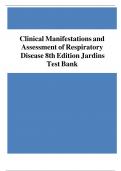Clinical Manifestations and
b b
Assessment of Respiratory
b b b
Disease 8th Edition Jardins
b b b b
Test Bank
b b
,Chapter b01: bThe bPatient bInterview
Des bJardins: bClinical bManifestations band bAssessment bof bRespiratory
bDisease, b8thbEdition
MULTIPLE bCHOICE
1. The brespiratory bcare bpractitioner bis bconducting ba bpatient binterview. bThe bmain bpurpose
bof bthisbinterview bis bto:
a. review bdata bwith bthe bpatient.
b. gather bsubjective bdata bfrom bthe bpatient.
c. gather bobjective bdata bfrom bthe bpatient.
d. fill bout bthe bhistory bform bor bchecklist.
ANS: b B
The binterview bis ba bmeeting bbetween bthe brespiratory bcare bpractitioner band bthe bpatient. bIt
ballows bthebcollection bof bsubjective bdata babout bthe bpatient’s bfeelings bregarding bhis/her
condition. bThe bhistory bshould bbe bdone bbefore bthe binterview. bAlthough bdata bcan bbe
breviewed,bthat bis bnot bthe bprimary bpurpose bof bthe binterview.
2. For bthere bto bbe ba bsuccessful binterview, bthe brespiratory btherapist bmust:
a. provide bleading bquestions bto bguide bthe bpatient.
b. reassure bthe bpatient.
c. be ban bactive blistener.
d. use bmedical bterminology bto bshow bknowledge bof bthe bsubject bmatter.
ANS: b b C
N bR bI bG bB.C bM
U bS
The bpersonal bqualities bthat ba brespiratory bN bT O
btherapist bmust bhave bto bconduct ba bsuccessful binterview
binclude
being ban bactive blistener, bhaving ba bgenuine bconcern bfor bthe bpatient, band bhaving bempathy.
bLeading bquestions bmust bbe bavoided. bReassurance bmay bprovide ba bfalse bsense bof bcomfort bto
bthe bpatient. bMedicalbjargon bcan bsound bexclusionary band bpaternalistic bto ba bpatient.
3. Which bof bthe bfollowing bwould bbe bfound bon ba bhistory bform?
1. Age
2. Chief bcomplaint
3. Present bhealth
4. Family bhistory
5. Health binsurance
bproviderba. b1, b 4
b. b2, b3
c. b3, b4, b5
d. b1, b2, b3, b4
ANS: b D
Age, bchief bcomplaint, bpresent bhealth, band bfamily bhistory bare btypically bfound bon ba bhealth
bhistory bform bbecause beach bcan bimpact bthe bpatient’s bhealth. bHealth binsurance bprovider
binformation, bwhilebneeded bfor bbilling bpurposes, bwould bnot bbe bfound bon bthe bhistory bform.
,NURSINGTB.COM
, 4. External bfactors bthe brespiratory bcare bpractitioner bshould bmake befforts bto bprovide
bduring banbinterview binclude bwhich bof bthe bfollowing?
1. Minimize bor bprevent binterruptions.
2. Ensure bprivacy bduring bdiscussions.
3. Interviewer bis bthe bsame bsex bas bthe bpatient bto bprevent bbias.
4. Be bcomfortable bfor bthe bpatient band
binterviewer.ba. b1, b 4
b. b2, b3
c. b 1, b2, b 4
d. b b b2, b3, b4
ANS: b C
External bfactors, bsuch bas ba bgood bphysical bsetting, benhance bthe binterviewing bprocess.
bRegardless bof bthebinterview bsetting b(the bpatient’s bbedside, ba bcrowded bemergency broom, ban
boffice bin bthe bhospital bor bclinic,bor bthe bpatient’s bhome), befforts bshould bbe bmade bto b(1) bensure
bprivacy, b(2) bprevent binterruptions, band b(3)bsecure ba bcomfortable bphysical benvironment b(e.g.,
bcomfortable broom btemperature, bsufficient blighting, babsence bof bnoise). bAn binterviewer bof beither
bgender, bwho bacts bprofessionally, bshould bbe bable bto binterview ba bpatient bof beither bgender.
5. The brespiratory btherapist bis bconducting ba bpatient binterview. bThe btherapist bchooses
bto busebopen-ended bquestions. bOpen-ended bquestions ballow bthe btherapist bto bdo
bwhich bof bthe bfollowing?
1. Gather binformation bwhen ba bpatient bintroduces ba bnew btopic.
2. Introduce ba bnew bsubject barea.
3. Begin bthe binterview bprocess.
4. Gather bspecific binformation.
a. b4 NURSINGTB.COM
b. b1, b3
c. b 1,
b2, b 3
d. b b b2,
b3, b4
ANS:
b C
An bopen-ended bquestion bshould bbe bused bto bstart bthe binterview, bintroduce ba bnew bsection bof
bquestions,band bgather bmore binformation bfrom ba bpatient’s btopic. bClosed bor bdirect bquestions bare
bused bto bgather bspecific binformation.
6. The bdirect bquestion binterview bformat bis bused bto:
1. speed bup bthe binterview.
2. let bthe bpatient bfully bexplain bhis/her bsituation.
3. help bthe brespiratory btherapist bshow bempathy.
4. gather bspecific
binformation.ba. b1, b 4
b. b b b2, b3
c. b 3, b 4
d. b b b1, b2, b3
ANS: b A
Direct bor bclosed bquestions bare bbest bto bgather bspecific binformation band bspeed bup bthe
binterview. bOpen- bended bquestions bare bbest bsuited bto blet bthe bpatient bfully bexplain bhis/her
bsituation band bpossibly bhelp bthebrespiratory btherapist bshow bempathy.




